(Washington, DC) – Members of the Colombian National Police have committed egregious abuses against mostly peaceful demonstrators in protests that began in April 2021, Human Rights Watch said today. Colombia’s government should take urgent measures to protect human rights, initiate a comprehensive police reform effort to ensure that officers respect the right of peaceful assembly, and bring those responsible for abuses to justice.
On April 28, thousands of people took to the streets in dozens of cities across Colombia to protest proposed tax changes. The government withdrew the proposal days later, but demonstrations about a range of issues – including economic inequality, police violence, unemployment, and poor public services – have continued. Police officers have responded by repeatedly and arbitrarily dispersing peaceful demonstrations and using excessive, often brutal, force, including live ammunition. Human Rights Watch has documented multiple killings by police, as well as beatings, sexual abuse, and arbitrary detention of demonstrators and bystanders.
“These brutal abuses are not isolated incidents by rogue officers, but rather the result of systemic shortcomings of the Colombian police,” said José Miguel Vivanco, Americas director at Human Rights Watch. “Comprehensive reform that clearly separates the police from the military and ensures adequate oversight and accountability is needed to ensure that these violations don’t occur again.”
While the protests have been mostly peaceful, some individuals have committed grave acts of violence in the context of the protests, including burning police stations and attacking police officers, two of whom died.
Human Rights Watch interviewed more than 150 people, most by phone, including victims, their relatives and lawyers, witnesses, justice sector officials, officials of the human rights Ombudsperson’s Office, and human rights defenders, in 25 cities across Colombia. Human Rights Watch also met with Colombia’s vice president, who is also the foreign minister; the police chief; the attorney general; and the head of the Military Justice System.
Members of the Independent Forensic Expert Group (IFEG) of the International Rehabilitation Council for Torture Victims (IRCT), an international group of prominent forensic experts, provided expert opinion on some evidence of abuses. Human Rights Watch also reviewed police and medical records, necropsy reports and photos of the victims, publications by local rights groups, and media reports. Human Rights Watch also corroborated more than 50 videos posted on social media and obtained information about the government’s response to past police abuses from the Ombudsperson’s Office, the Inspector General’s Office, and the Defense and Interior Ministries.
Human Rights Watch has received credible reports of 68 deaths occurring since the protests began. Human Rights Watch received reports of these deaths through local groups, including Temblores and Defender la Libertad, a coalition of rights groups documenting police violence, and independently documented each case with direct evidence.
So far, Human Rights Watch has confirmed that 34 deaths occurred in the context of the protests, including those of 2 police officers, 1 criminal investigator, and 31 demonstrators or bystanders, at least 20 of whom appear to have been killed by the police. Armed people in civilian clothes have attacked protesters, killing at least five.
Colombian authorities should carry out prompt and independent investigations into all cases of police abuse and other serious acts of violence, including by armed people in civilian clothes who have attacked protesters, Human Rights Watch said. They should also investigate any officers who may have failed to protect demonstrators from attacks by others.
Credible evidence indicates that the police killed at least 16 protesters or bystanders with live ammunition fired from firearms, Human Rights Watch found. The vast majority of them had injuries in vital organs, such as the thorax and head, which justice sector officials said are consistent with being caused with the intent to kill.
At least one other victim died from beatings and three others from inappropriate or excessive use of teargas or flash bang cartridges.
Over 1,100 protesters and bystanders have been injured since April 28, according to the Ministry of Defense, though the total number is most likely higher as many cases have not been reported to authorities. Human Rights Watch documented nine cases of severe eye injuries, including seven with likely permanent loss of vision in one eye, apparently from teargas cartridges, stun grenades, or kinetic impact projectiles fired from riot guns.
Victims injured include journalists and human rights defenders who were covering the protests, including many who wore vests identifying them as such.
On June 3, the Ministry of Defense said that, since April 28, police officers had detained over 1,200 people for crimes allegedly committed during the protests. Prosecutors had only charged 215. Hundreds were released after a judge or prosecutor concluded that there was no evidence linking them to a crime, or that their due process rights were violated during detention, the Attorney General’s Office told Human Rights Watch.
In addition, the police took into custody over 5,500 people using a legal provision that allows police officers to “transfer” a person to an “assistance or protection center” to “protect” them or others. Human Rights Watch documented multiple cases of arbitrary detention, including by misusing the “protection” provision.
On May 14, the Ombudsperson’s Office reported 2 cases of rape, 14 cases of sexual assault, and 71 other cases of gender-based violence by police officers, including slapping and verbal abuse. Colombian rights groups have reported additional cases. Human Rights Watch documented two cases of sexual violence by police officers against protesters.
Human Rights Watch also documented 17 beatings, often with police truncheons. One victim, Elvis Vivas, 24, died in a hospital after a brutal beating by police officers.
At least 419 people have been reported missing since the protests began. On June 4, the Attorney General’s Office said that it had found 304 of them. In some cases, the people who reported them missing were not aware that they had been detained.
While most demonstrations were peaceful, some individuals engaged in serious acts of violence, including attacking police officers and police stations with rocks and Molotov cocktails, looting, and burning public and private property. As of June 2, over 1,200 officers had been injured, at least 192 severely, 2 officers had died and 7 officers remained hospitalized, according to the Defense Ministry. Twenty police officers had been injured by firearms, the police chief said. On April 29, several people beat up and sexually abused a woman police officer as they attacked a police station in Cali.
Some protesters blocked roads for prolonged periods, at times limiting or impeding the distribution of food or the circulation of ambulances, particularly in the states of Valle del Cauca and Cundinamarca. These limitations have at times undermined access to health supplies, including oxygen for patients with Covid-19, the Health Ministry said. A newborn baby girl died on May 23 after protesters blocked the ambulance that was carrying her between Cali and Buenaventura.
“Violence against police officers and road blocking that impedes access to food or health services are unjustifiable, but they are no excuse for police brutality,” Vivanco said.
Incidents of abuse by the police in 2019 and 2020 prompted calls for comprehensive police reform, including from Human Rights Watch.
The Colombian police force is under the authority of the Defense Ministry and has been deployed to fight armed groups alongside the armed forces, in a manner that has often blurred their distinct functions. In situations involving armed conflict, the use of force is governed by international humanitarian law, and the rules are very different than in a civilian context, such as in protests. Police officers implicated in abuses are also often tried in military courts, where there is little chance of accountability.
Colombia needs a civilian force that is trained to respond to protests in a manner respectful of human rights, and whose members are held accountable for abuses, Human Rights Watch said. Establishing a clear separation between the police and the military is a key first step.
On June 6, President Iván Duque announced that his government would take steps to “transform” the police. Some of the initiatives, such as a proposed reform of the police’s disciplinary system, could have a positive impact on police abuses if properly designed and implemented, Human Rights Watch said. But other proposals seem cosmetic, and, overall, the changes announced fall short of the reforms needed to prevent human rights violations and hold those responsible to account.
President Duque has acknowledged that the police committed some abuses and said officers involved would be prosecuted and punished. But Duque has rejected other major proposals for police reforms, claiming that his government has “zero tolerance” toward abuse.
Yet the police’s internal disciplinary system, which lacks necessary independence, has failed to hold officers responsible for abuses in protests in 2019 and 2020, data obtained by Human Rights Watch shows. The Attorney General’s Office, which conducts criminal investigations, has also failed to achieve meaningful progress in investigations into abuses committed during those protests.
For detailed recommendations and further information on Human Rights Watch’s findings, please see below.
Arbitrary Dispersal of Peaceful Protests; Excessive Use of Force
The Colombian government deployed regular police officers and members of the police anti-riots squadron (ESMAD) to respond to the protests. The regular officers attend a 45-hour course on responding to peaceful demonstrations every two years, but do not receive anti-riot training, the police chief told Human Rights Watch.
Additionally, since May 1, President Duque has deployed the army to “assist” the police, though not to use force against protesters. On May 28, Duque increased the number of deployed soldiers, and ordered several governors and mayors to work with security forces to “adopt the necessary measures” to disperse “blockades.”
Under international human rights law, the authorities should protect peaceful assemblies and should not disperse them even if they consider them unlawful. They should avoid using force unless necessary and proportionate to respond to specific incidents of violence. Peaceful protests that block traffic may be dispersed, as a general rule, only if they cause serious and sustained disruptions.
However, Human Rights Watch has documented repeated instances in which the ESMAD or police violated these principles, arbitrarily dispersing peaceful protests, or using indiscriminate and excessive force, including firearms.
Unlawful Use of Lethal Weapons
Under international human rights standards, firearms may only be used when strictly necessary to address an imminent risk to life or physical integrity. The use of firearms to disperse an assembly is always unlawful.
Under Colombian law, police can use lethal weapons to defend themselves or others “when there is imminent threat of death or serious injury, or to prevent a particularly serious crime that involves a serious threat to life.”
The Colombian police chief told Human Rights Watch that police, including regular officers and members of the anti-riots squadron (ESMAD), have not used lethal weapons during the demonstrations.
However, Human Rights Watch corroborated several videos showing police officers shooting in the context of the demonstrations, in circumstances in which there appeared to be no risk to life or physical integrity.
Human Rights Watch documented 16 cases in which the police appear to have killed unarmed protesters or bystanders with live ammunition. In at least 15 of those cases, the victims had gunshot wounds in vital organs: 7 were shot in the thorax, 6 in the head, and 2 in the abdomen. Those injuries are consistent with an intent to kill, justice sector authorities told Human Rights Watch.
Kevin Antoni Agudelo
22, Shopkeeper Cali, Valle del Cauca More “
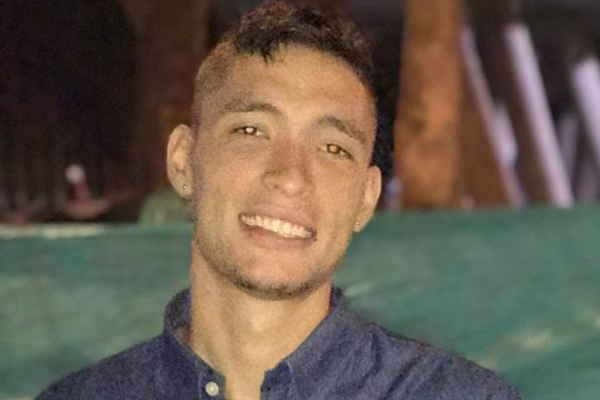
Kevin Antoni Agudelo
Kevin Agudelo, 22, a shopkeeper, was shot at around 10:15 p.m. on May 3 in Cali, Valle del Cauca state. He died of his wounds. He had been participating in a candlelight vigil for people injured in previous protests, two witnesses said. Demonstrators at a roundabout were peacefully blocking traffic when ESMAD agents began firing flash bang cartridges and teargas, three witnesses said. Several protesters responded by throwing rocks. One witness said he heard shots that sounded like live ammunition. He said that Agudelo, who had been hiding behind a post, then ran toward him along with another protester. The witness said he saw a police officer shoot Agudelo from a short distance. The other protester was also injured, he said. Human Rights Watch reviewed three videos that appear consistent with the witnesses’ accounts, in which Agudelo is seen lying next to the injured protester. Human Rights Watch reviewed a photo of Agudelo’s body, with wounds to the chest and arms, which IFEG forensic experts said were consistent with being shot by live ammunition. A justice sector official familiar with the case said initial evidence indicates the police were responsible for the shooting.
Santiago Andrés Murillo
19, Student Ibagué, Tolima More “
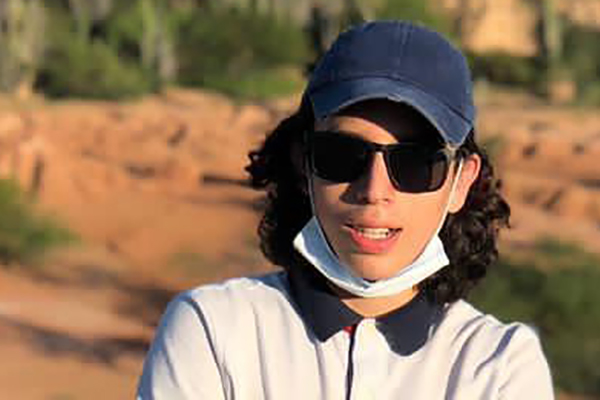
Santiago Andrés Murillo
Santiago Andrés Murillo, 19, a student, in the town of Ibagué, Tolima state, was shot at around 10 p.m. on May 1, as he walked home from his girlfriend’s house, his mother and girlfriend said. A video corroborated by Human Rights Watch shows several protesters attending to Murillo lying on the ground. Human Rights Watch reviewed photos of Murillo’s body, showing wounds to the left armpit and chest, which IFEG forensic experts said are consistent with having been shot by live ammunition. Military justice officials arrested two police officers on homicide charges on May 6 and released them on June 2. A prosecutor asked the Constitutional Court on May 11 to rule that only the Attorney General’s Office – not the military justice system – should investigate the case. A decision remains pending.
Nicolás Guerrero
26, Graffiti artist Cali, Valle del Cauca More “
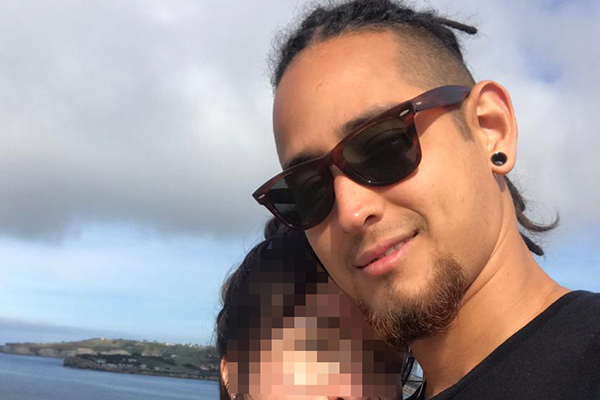
Nicolás Guerrero
Yinson Andrés Angulo Rodríguez
23, Electrician Cali, Valle del Cauca More “
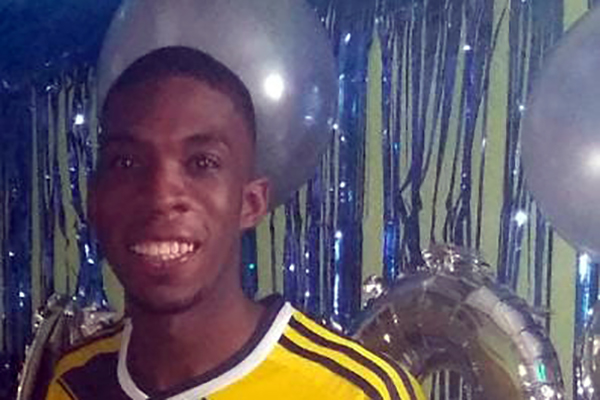
Yinson Andrés Angulo Rodríguez
Yinson Andrés Angulo Rodríguez, 23, an electrician, died from a gunshot at around 4:40 p.m. on May 1, in Cali. He and a friend had been walking, observing the protests, and stopped at the park in the Calimio neighborhood, his friend said. Protesters were throwing rocks, and police were responding with teargas and stun grenades. Two stun grenades hit demonstrators in the front row, the friend said, and as everyone ran, he heard several shots. He turned to look for Angulo and could not find him. He approached some people who were shouting, “Take him out, he has been shot, he has been injured.” They were bending over Angulo’s limp body. A motorcycle took him to the Joaquín Paz Borrero hospital. A justice sector official familiar with the case said that live ammunition killed Angulo and that initial evidence indicated that it belonged to the police.
Edwin Villa Escobar
38, Gas technician Cali, Valle del Cauca More “

Edwin Villa Escobar
Edwin Villa Escobar, 38, a gas technician, was killed on April 30 in Cali. Villa was cooking soup outdoors for other protesters in the Diamante neighborhood, when at around 4:30 p.m., police tried to disperse the demonstration, a relative of the victim said. Some protesters threw rocks at the police in response and officers began firing live ammunition, videos corroborated by Human Rights Watch show. Villa was injured. A demonstrator took him to a local clinic, where doctors transferred him to a hospital for urgent surgery. He died hours later. Doctors told the family he had been injured with live ammunition in the left ear. A justice sector official familiar with the case said that the evidence indicates the police was responsible for the shooting.
Marcelo Agredo Inchima
17, Student Cali, Valle del Cauca More “
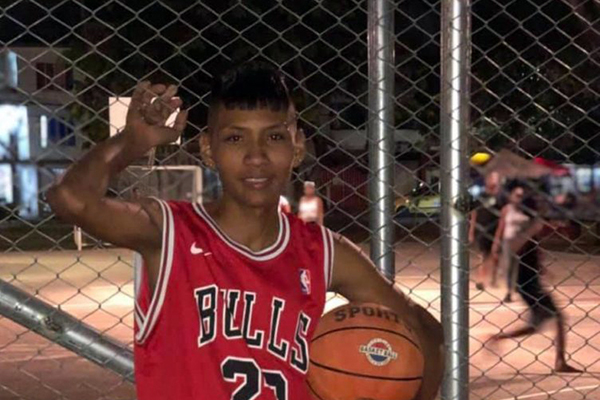
Marcelo Agredo Inchima
Indiscriminate and Improper Use of Less Lethal Weapons
Police repeatedly used teargas against peaceful protesters, demonstrators and officials of the Human Rights Ombudsperson’s Office said.
It appears that police deployed teargas from riot guns in a reckless and dangerous manner on multiple occasions. Police should fire teargas cartridges toward the sky, to slow down the heavy projectile’s trajectory in a downward arc to land on the ground. However, interviews with multiple protesters and human rights officials and videos corroborate that police officers shot the cartridges straight into the crowd.
The Colombian police also used a launching system, known as Venom, to shoot up to 30 teargas, smoke or flash bang cartridges at a time. Human Rights Watch corroborated videos of its use in several cities, including Bogotá and Popayán (Cauca state). The system is supposed to shoot projectiles in a “parabolic” trajectory – that is, toward the sky – to avoid “direct impact” against protesters, police told Human Rights Watch in a letter. But the letter also says it shoots from an angle as small as 10 degrees, which would not make it “parabolic.”
Human Rights Watch corroborated videos of police shooting the Venom from the ground straight toward demonstrators in Popayán.
This launching system has wide-area indiscriminate effects and cannot be used in a way that distinguishes any legitimate threats, Human Rights Watch said. Its usage is inappropriate for peaceful protests. Even if isolated events of violence occur in the context of protests, police need to respond in a proportionate, not indiscriminate, manner.
Human Rights Watch documented cases of five people apparently injured by the impacts of teargas cartridges and three killed, including:
Brayan Niño Araque
24, Furniture store employee Madrid, Cundimarca More “
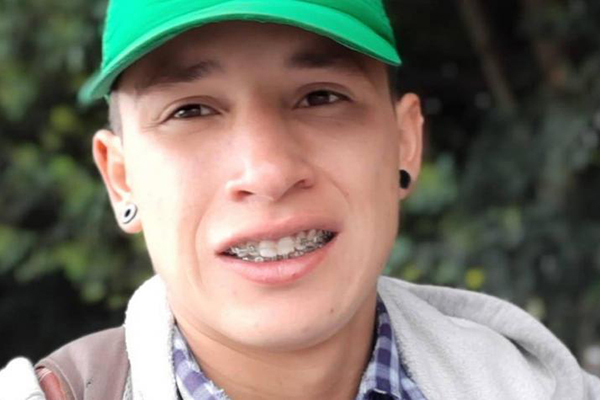
Brayan Niño Araque
Brayan Niño Araque, 24, a furniture store employee, was killed when a cartridge hit him in the eye at around 9 p.m. on May 1 in Madrid, Cundinamarca state. He was participating in a peaceful protest when ESMAD agents in an armored wheeled vehicle began shooting teargas cartridges directly at protesters as they ran away, several witnesses said. One said he saw a cartridge shot from the armored vehicle hit Niño, who was running away but had, seconds earlier, turned to look back. Human Rights Watch corroborated a photo of the wound to Niño’s right eye, which the IFEG forensic experts say is consistent with impact from a teargas cartridge. A justice sector official familiar with the case said that the blow to the eye caused Niño’s death. Human Rights Watch corroborated videos of an armored vehicle shooting what appeared to be teargas cartridges at protesters that night. Military justice authorities on May 6 ordered the arrest of a police officer on homicide charges. A prosecutor asked the Constitutional Court on May 13 to rule that only the Attorney General’s Office – not the military justice system – should investigate the case. A decision remains pending.
Juan Pablo Fonseca
25, Student chef and assistant cook Bogotá More “

Juan Pablo Fonseca
Juan Pablo Fonseca, 25, a student chef and assistant cook, saw an ESMAD agent fire the teargas cartridge that smashed his right eye during protests in a northern neighborhood of Bogotá on May 1. The agent fired straight at his face, he said. Another witness said that police were firing teargas canisters directly at protesters on the corner where Fonseca was hit. A passer-by took Fonseca to a clinic, where doctors removed his right eye. As of May 14, Fonseca had undergone four surgeries.
Joan Alejandro Martínez Díaz
20, Student Bogotá More “
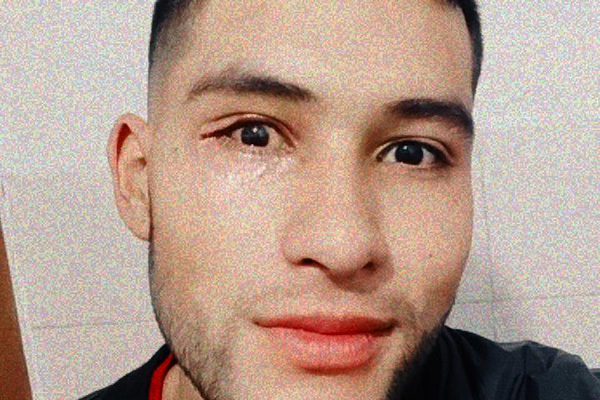
Joan Alejandro Martínez Díaz
Joan Alejandro Martínez Díaz, 20, a physics student, was participating in a protest on Avenida de las Américas, in Bogotá, on the night of May 4, when an ESMAD agent shot him in the face with a teargas cartridge, Martínez said. The front row of protesters was throwing rocks at police, Martínez said, but he was walking away, trying to distance himself from them. He turned to see the police beating a protester and saw an agent shoot him with the cartridge. The agent gave no warning, he said, shooting straight at him. A passer-by on a motorcycle drove Martínez to the hospital, where he was treated for bleeding, a bruised forehead, and swelling of his left eye. Human Rights Watch reviewed a doctor’s report that says he is unlikely to regain sight in that eye.
In 2019, Colombian police fired pellets using 12-gauge pellet shotguns against protesters, killing one protester. In January 2020, the Inspector General’s Office, an independent body, found that police officers had limited, if any, training on how to use the weapon. In September 2020, the Supreme Court suspended the use of those weapons by police.
The police chief told Human Rights Watch that police are not currently using any kind of pellet shotguns. He said the 12-gauge pellet shotguns remain stored in police stations.
The police said they are using riot guns to fire cartridges containing 12 or 24 balls that they said are made of plastic. Human Rights Watch documented several cases in which protesters appear to have been injured by these kinetic impact projectiles.
Some were hit by multiple projectiles at the same time, suggesting they were shot at close range, given that these projectiles scatter over a distance.
Juan Rojas, and Fernando Espinosa, and Camilo Rojas
Journalists Sibaté, Cundinamarca More “
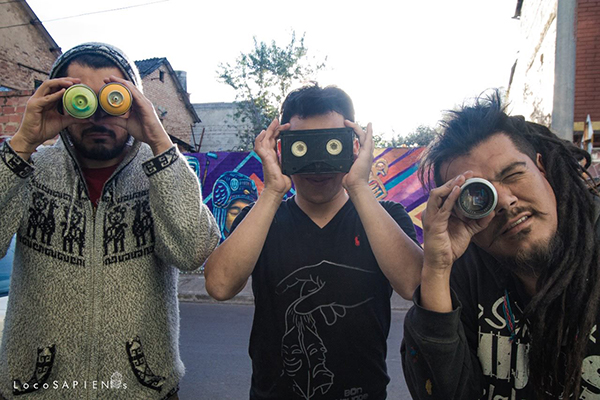
Juan Rojas, and Fernando Espinosa, and Camilo Rojas
Juan Rojas, 35, and Fernando Espinosa, 35, both journalists, were covering a sit-in protest in Sibaté, Cundinamarca state, on May 6, a fellow journalist who was present said. As ESMAD agents approached, the three shouted that they were members of the press. But an ESMAD agent opened fire from no more than two meters away with a riot gun; Human Rights Watch corroborated a video showing the agent firing the weapon at them. The projectiles struck Espinosa in the chest, and Rojas in the left thigh, leaving bruises. Human Rights Watch reviewed photos of the bruises, which the IFEG forensic experts said are consistent with injuries caused by kinetic impact projectiles.
Nicolás Saavedra
23, Electrician Bogotá More “
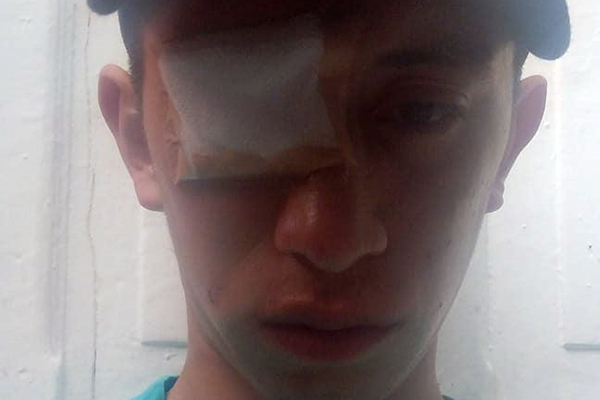
Nicolás Saavedra
Nicolás Saavedra, 23, left work early on April 28 to participate in protests at Plaza de Bolívar, in Bogotá. He was watching performers, and the crowd was peaceful, when ESMAD agents burst into the square firing teargas, stun grenades and kinetic impact projectiles, he said. Saavedra heard an explosion close-by and felt searing pain. Shock kept him from running, as the people around him scattered. A childhood friend realized Saavedra’s right eye was bleeding profusely and took him to the hospital. A medical report Human Rights Watch reviewed noted multiple wounds not only to the right eye but to the hands, back, and right arm. Saavedra has lost all vision in his right eye.
“Emmanuel Lovato”
22, Student Pereira, Risaralda More “

“Emmanuel Lovato”
Emmanuel Lovato (pseudonym), 22, a student, who like some others are identified by pseudonyms in this document for their protection, has less than half of the vision remaining in his right eye, after being hit by what he believes were kinetic impact projectiles. The demonstration at Parque Olaya, in the city of Pereira, Risaralda state, on May 2, had been peaceful, he said, until ESMAD agents arrived. Lovato saw the motorcycle agent who fired at his face from about 20 meters away, he said. Kinetic impact projectiles hit him below his right eye and impacted his right arm. The blow to the area of his eye caused the lower eyeball to burst, medical documents reviewed by Human Rights Watch said. Specialists are uncertain whether Lovato will regain some of his lost vision; he is avoiding sudden movement to prevent a total detachment of the retina, which they told him can result in permanent blindness.
“Luis Miguel Gómez”
25, Bus driver Cali, Valle del Cauca More “
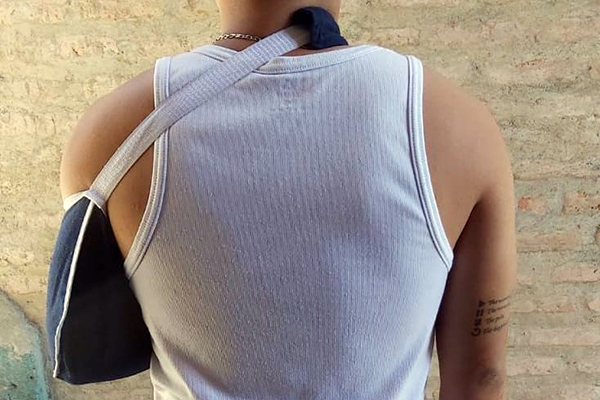
“Luis Miguel Gómez”
Luis Miguel Gómez (pseudonym), 25, was returning home after a sit-in in Cali, on May 1, when ESMAD and regular police agents, in a pincer movement, rounded him up with other protesters. They fired stun grenades and kinetic impact projectiles as they advanced, Gómez said. One of Gómez’s friends fell, and an ESMAD agent kicked him. As Gómez implored the agent to stop, a regular police officer approached and, from about two meters away, without giving any notice or command, shot his left wrist, Gómez said. A doctors’ report that Human Rights Watch reviewed said that a “rubber bullet” had broken Gomez’s radial bone and severed his tendon at the wrist, as well as injuring a finger.
Beatings
Human Rights Watch documented 17 cases of protesters or bystanders being beaten, often with police truncheons. Some were later detained. One died due to the injuries.
Elvis Vivas
24, Car assembly worker Madrid, Cudinamarca More “

Elvis Vivas
Police beat Elvis Vivas López, 24, on the night of May 1, in Madrid, Cundinamarca state, several videos Human Rights Watch corroborated show. The officers dragged him by his feet and arms to a nearby police station, the videos show. Two witnesses said that they saw Vivas leaving the police station that night. He had a large injury in the head, they said, and was disoriented. They took him to a hospital, where Vivas told doctors that the police beat him, a medical record Human Rights Watch reviewed shows. The doctors performed surgery and put him in an induced coma due to head injuries, his family members said. Vivas died on May 7. A justice sector official familiar with the case said that the evidence points to police responsibility.
Kevin Díaz
18, Student Bogotá More “

Kevin Díaz
Police beat Kevin Díaz, 18, and his 16-year-old girlfriend, near South Ecological Park in Bogotá, as they returned home from his sister’s house, Díaz said. Police and protesters had blocked the streets, and they found themselves being pushed with the crowds toward the center of the protests; then trapped near a police station where protesters and police were throwing stones, Díaz said. He and his girlfriend broke away, sometime after 9 p.m., and ran toward the park. At least 10 police on motorcycles chased them down and started beating them. Díaz tried to protect his girlfriend. An officer pointed a gun at her. Neighbors started screaming and the officers left, Díaz said. Human Rights Watch corroborated a video of the scene where a woman is checking Díaz’s injuries. Other people seen in the video say she is a nurse. Human Rights Watch also reviewed photos showing injuries on Díaz’s back, arms, right leg, and the left side of his face. His girlfriend was not injured.
“Samuel Rodríguez”
24, Student Medellín, Antioquia More “

“Samuel Rodríguez”
Samuel Rodríguez (pseudonym), 24, a student, participated in a protest in the afternoon of May 1, in Parque de las Luces, Medellín, Antioquia state. Several protesters were throwing rocks at police, who responded with teargas, Rodríguez said. He was nearly 200 meters from the scene of the violence when, at around 4 p.m., a motorcycle rammed him. The officers on the motorcycle hit him with truncheons and fists, kicked him, and grabbed him by the neck, he said. Rodríguez could not breathe, he said. Police dragged him a few meters away, where more officers joined in the beating. An officer said they were going to detain him, but Rodríguez got away, bleeding heavily. Human Rights Watch corroborated a video that shows him, injured and bleeding, walking in a street in Medellín minutes later.
Joseph Felipe Fonseca Téllez
19, Student Bogotá More “

Joseph Felipe Fonseca Téllez
Joseph Felipe Fonseca Téllez, 19, was walking with his sister and cousin along Avenida Caracas, in Bogotá, on the afternoon of April 28, when they ran into a group of police beating a young man, Téllez said. Téllez’s sister asked them to stop. Police responded by beating Téllez and his cousin, and detaining Téllez’s sister. An officer beat Téllez’s cousin with a truncheon while another one used a radio and a truncheon to hit his cousin in the head. Téllez and his cousin ran to escape the beatings, and an ESMAD agent threatened to shoot them with a teargas cartridge, Téllez said. Officers held Téllez’s sister for an hour. Human Rights Watch reviewed photos showing cuts on Tellez’s head and injuries to his cousin’s left cheek that are consistent with their statements.
Gender-Based Violence
On May 14, the Ombudsperson’s Office reported 2 cases of rape, 14 cases of sexual assault, and 71 other cases of gender-based violence by police officers, including slappings and verbal abuse. Colombian rights groups have reported additional cases. Human Rights Watch documented two cases of sexual violence by police officers against protesters:
Jessica Amaya
32, Artisan Yumbo, Valle del Cauca More “

Jessica Amaya
Jessica Amaya, 32, participated in a protest that started on the morning of April 28 in the town of Yumbo, Valle del Cauca state. It was a peaceful event, with performances, Amaya said, and entire families attended. Around 9 p.m., ESMAD agents arrived by truck. Protesters started retreating and ESMAD officers chased them to the center of a traffic circle, Amaya said. An officer grabbed Amaya’s leg as she ran away and threw her to the ground. Beatings were “raining” on her, Amaya said. She covered her head and face with her arms, but after what she remembered as four heavy blows to the head, she passed out. She woke up about two hours later, under a bush, with blood on her clothes and a breast exposed. “I felt defiled, I feel that they have abused me, but I don’t remember what they did to me,” she said. The attack left her with abdominal pain, and she received eight stitches to repair various cuts on her head. She said the authorities told her they could only do a forensic medical examination after she filed a criminal complaint. She went to the prosecutor’s office in Yumbo the day after the incident, but it was closed due to the demonstrations. Human Rights Watch reviewed photos showing Amaya’s bruises and swelling. Amaya was examined in a private clinic on May 14. A group of medical doctors and psychologists who examined her concluded that she appeared to have been a victim of sexual violence, a medical report Human Rights Watch reviewed shows. Amaya reported the incident to prosecutors on May 21.
“Marta Alejandra Aguilar”
18, Student Palmira, Valle del Cauca More “

“Marta Alejandra Aguilar”
Marta Alejandra Aguilar (pseudonym), 18, a student, was walking home, with four friends, from a protest in the city of Palmira, Valle del Cauca state, at around 4:30 a.m. on May 3, when a police officer asked to search one of Aguilar’s friends. The officer did not say why, Aguilar said. Her friend refused and other officers took four of them to a police station; the fifth escaped. A female officer took Aguilar to a bathroom, forced her to squat naked, and patted her down. A male officer entered the bathroom while she was still naked and asked the female officer to leave, Aguilar said. The male officer then started groping Aguilar. “He told me they were going to make me disappear, that they were going to take me to the back and rape me until I couldn’t take it anymore … that I was a whore,” she said. The officer led her toward the back of the station, but another officer stopped him and took Aguilar back to where her friends were. The officers handcuffed them all and photographed them with the milk and saline water that they had brought to the protests to relieve the effects of teargas. The officers let them leave after seven hours only after they signed a statement saying that they had not been harassed, mistreated, or beaten during their detention, Aguilar said. The police did not give them a copy. They were never accused of any crime or brought before a prosecutor or a judge.
Arbitrary Detention; Disproportionate Charges
Hundreds of protesters were detained by police and released after a judge or prosecutor concluded that there was no evidence linking them to a crime, or that their due process rights had been violated during detention, the Attorney General’s Office said. Human Rights Watch documented in detail 27 cases of people who appear to have been arbitrarily detained. Prosecutors, human rights officials, and victims’ lawyers reported scores of additional cases.
Prosecutors have also filed disproportionate charges of “terrorism” against some demonstrators who allegedly engaged in vandalism. While the penalty for destruction of property is between 16 and 90 months, the penalty for terrorism is up to 22 years-and-a-half in prison. International human rights standards require that criminal charges and penalties be proportionate to the gravity of the conduct at issue and the culpability of the alleged offender. Authorities should not arbitrarily use “terrorism” charges to address lower-level offenses, Human Rights Watch said.
The police also took into custody over 5,500 people using a legal provision that allows police officers to “transfer” a person to an “assistance or protection center” for their own “protection” or that of others. Human Rights Watch documented several cases in which police officers appear to have misused this provision.
The law allows for such “transfer” only when it is the “only means available to prevent a risk to life or physical integrity” and requires first contacting relatives of the person to see if the person can be transferred to their care; if the relatives cannot assume their care, police are to take them to an “assistance center,” health center, hospital, or other location specifically designated for such transfers by the municipal government, or to their homes if possible.
The law says that people may not under any circumstances be transferred to detention centers. In the cases documented by Human Rights Watch, the police took people to police stations instead of to health centers or administrative detention sites and police did not call their relatives first, as required under Colombian law.
Stiven Álvarez
33, Musician Medellín, Antioquia More “
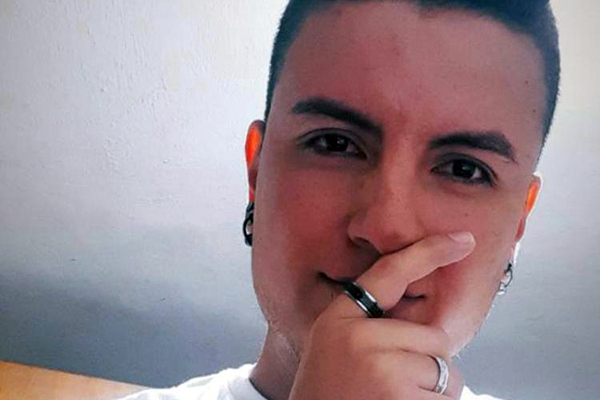
Stiven Álvarez
As Stiven Álvarez, 33, walked home from a protest in downtown Medellín on the afternoon of May 1, uniformed officers on motorcycles accosted him, asking what he was doing. When he said he was doing nothing, they began beating him. Álvarez escaped, running, but the police chased him by motorcycle and finally ran him over, leaving his foot stuck under a wheel. Officers beat him again, Álvarez said, with truncheons, fists, and helmets. They kicked him and threatened to kill him, he said, then arrested him, without saying why, and took him by motorcycle to a police station. He spent almost three hours in an improvised cell, in the station’s patio, with sixteen other people. Police occasionally passed by to hit detainees and threaten them, Álvarez said. Human Rights Watch reviewed a document police gave him, which accuses him of being “part of a group of people that were committing vandalism.” Álvarez denied the accusation. After three hours, officers took him to a separate facility, under the provision of Colombian law allowing them to “transfer” people to “protect” them or others. They did not say why. After three more hours, they released him. Álvarez has not been formally charged with any crime.
Johan Sebastián Moreno Castro
27, Human rights defender Bucaramanga, Santander More “

Johan Sebastián Moreno Castro
Johan Sebastián Moreno Castro, a 27-year-old lawyer and member of the human rights group Equipo Jurídico Pueblos, was documenting abuses at protests in the city of Bucaramanga, Santander state, on May 4, around 9 p.m., when he said two police officers attacked him. Officers threw him to the ground, kicked him, grabbed him by the neck, and shoved him violently against a wall. An officer beat his head with a stun grenade, he said. Police and ESMAD officers dragged him down the street, bleeding, unable to walk, and barely conscious, Moreno said. Human Rights Watch corroborated a video of the officers dragging him. They lifted Moreno onto a police motorcycle, and he recalls going in and out of consciousness while a police captain who was also on the motorcycle berated him: “Son of a bitch, you are not a human rights defender; you are a guerrilla fighter. I am going to show you how to faint for real.” At a police station, the captain told him he would be prosecuted for “violence against a public servant,” “obstruction of roads,” and “property damage.” Police videoed and photographed Moreno during a medical examination at a nearby hospital and a meeting with a prosecutor. He spent all night at the police station, handcuffed, sleeping on a chair by the door. Human Rights Watch corroborated a video of him upon his release the next morning, hardly walking, with blood on his shirt. Moreno has not been charged.
Police detained José Mauricio García Nieto, 24; Dan Brayer Andrade Bolaños, 22; José Mario Ramírez Álzate, 22; Daniel Navarrete Varón, 22; Jorge Andrés Noguera Flórez, 23; and Santiago Ramírez Duque, 26; in the afternoon of May 25 in Tuluá, Valle del Cauca. The police report said that at the time of their arrest, four of them were throwing rocks at buildings, one was lighting a plastic bottle to supposedly throw it at a police station, and the sixth was “inciting” people to “oppose a police operation.”
At an online hearing before a judge next day, whose video recording Human Rights Watch reviewed, the prosecutor charged the six individuals arrested in Tuluá with “terrorism.” The only evidence he presented was the police report and statements by police. The prosecutor acknowledged that the specific acts allegedly committed could amount only to a crime of destruction of property, but said the “terrorism” charge was justified because the detainees were part of a “mob” that “agitated” them. The prosecutor did not present any evidence that they were acting in coordination with each other or with other protesters, and acknowledged that they were not involved in the burning of the Tuluá courthouse, which happened that night. Colombian law does not allow pretrial detention of defendants charged with destruction of property, a minor crime, but it does for terrorism.
The prosecutor also said at the hearing the detainees had told him through WhatsApp calls that the police had beaten them. However, the detainees were not taken to see a medical examiner to document the injuries, a separate police report reviewed by Human Rights Watch shows, allegedly due to the unrest in the city. Without presenting any evidence, the prosecutor said that there was a “possibility” that they had resisted arrest and that it was “possible” that the use of force by the police was appropriate. The judged agreed – and ruled that the arrest was legal.
On May 28, the same judge ruled that the detainees were a “threat to the community” and ordered that they be held in pretrial detention. The six young men remain imprisoned in jail in Popayán, their lawyers and relatives told Human Rights Watch.
Alleged Participation of Armed Groups and Civilians
The Colombian government said that several armed groups, including the National Liberation Army (ELN) and groups that emerged from the Revolutionary Armed Forces of Colombia (FARC), had “infiltrated” the protests to commit vandalism and attack the police. The Attorney General told Human Rights Watch on June 4 that the authorities arrested 11 alleged members of armed groups in connection with violence during demonstrations.
Separately, armed people in civilian clothes have engaged in violence against protesters. In Pereira, Risaralda state, a group of people in civilian clothes appeared when Lucas Villa, a protester and social leader, was delivering a speech against the government during a protest on May 5. One of them shot and killed him, a witness who was also severely wounded told Human Rights Watch. Justice sector officials familiar with the case said that the evidence indicates local drug trafficking groups may be responsible.
In some cases, police officers failed to respond when people in civilian clothes engaged in violence against protesters. Human Rights Watch corroborated videos showing armed men firing at protesters while standing next to police officers in Cali on May 28. The police did not appear to take action to prevent or stop the attacks. The next day, a police commander acknowledged that the agents had “failed to comply with their duty” and said they would be investigated.
The director general of the Police, General Jorge Luis Vargas, said that no plainclothes police officers had been deployed for crowd control operations or to arrest protesters. However, Human Rights Watch corroborated videos showing that police officers in civilian clothes arrested protesters who were blocking a highway in Cali on May 17.
Limited Accountability for Police Abuses
Colombian authorities, including the Attorney General’s Office, which conducts criminal investigations, and the police and the Inspector General’s Office, which can carry out disciplinary proceedings, have made limited progress in investigating police abuse against protesters.
The Attorney General’s Office told Human Rights Watch on June 4 that it had charged only one police officer in connection with abuses committed during the recent wave of protests. He was charged on May 13 for the homicide of a protester, Marcelo Agredo Inchima. The Attorney General’s Office’s Unit of Citizen Security, which is conducting all the investigations into police abuses, said it had appointed additional prosecutors and investigators to handle these cases and that the head of the unit was conducting weekly meetings with prosecutors to assess progress in each case.
The director of the Military Justice System told Human Rights Watch on May 28 that military judges had opened 34 investigations in connection with the protests, including for 10 killings and 11 cases of injuries. Under regional human rights norms, grave human rights violations should not be tried before military courts.
The police chief said on May 31 that the police had opened disciplinary investigations into 170 officers for possible misconduct during the current wave of protests. Of those, three are under disciplinary investigation for homicide and have been temporarily suspended, two have been suspended for other alleged infractions, and the rest continue their regular work. The Inspector General’s Office, which also conducts disciplinary investigations, said on May 31 that it had opened 78 investigations into possible abuses of power and excessive use of force by police officers; the vast majority remained in preliminary stages.
Progress in investigating police abuses in previous protests has also been lacking. On June 4, the Attorney General’s Office told Human Rights Watch that it had opened 90 investigations into police abuses during the 2019 protests and other 116 during the 2020 protests. The office said a trial had started in five of the 2020 cases and that it had brought charges in two others. No officer has been charged in connection with abuses committed during the 2019 protests.
The Inspector General’s Office has also failed to achieve meaningful progress. On May 10, the office told Human Rights Watch that it had opened 24 investigations of police abuses during the 2019 protests and another five during the 2020 protests. No officer had been disciplined and most cases remained in preliminary stages.
On April 17, 2021, the Defense Ministry told Human Rights Watch that police had opened 40 disciplinary investigations in connection with the 2019 protests. Of those, 24 had been closed without any officer being disciplined, the ministry said, while the others were pending. The ministry said that 54 of the 92 disciplinary investigations the police had opened in connection with the 2020 protests had been closed, in most cases because the investigators could not identify the police officer involved. Only two officers had been disciplined in cases that appeared connected to human rights violations and four others had been acquitted.
The police disciplinary system lacks independence, Human Rights Watch found. There is no separate career for disciplinary investigators, the police chief said. This means that there are no safeguards to ensure that investigators do not end up working alongside, or under the command of officers they previously investigated. Colombian law also allows the police chief to revoke any disciplinary decision.
The police chief asserted that the disciplinary system is overwhelmed with proceedings for minor issues, which he said slow down the progress of investigations into serious offenses. He said he is working on a reform to improve the handling of the most serious offenses and transfer cases concerning “serious human rights violations” to the Inspector General’s Office, an independent body.
Possible Contempt of Supreme Court Ruling
In September 2020, the Supreme Court ordered several police reforms to prevent abuses during protests. Yet Human Rights Watch found that efforts to comply with the court’s ruling have been mostly pro forma and have had little impact on police actions. The main exception is the Supreme Court’s ban of the 12-gauge shotgun, a weapon which, to Human Rights Watch’s knowledge, police have not used during the current wave of protests.
The Supreme Court ordered the Colombian government to establish a new protocol on the “use of force during peaceful demonstrations.” The government did publish a new protocol in January 2021, but it does not include any new measures or oversight mechanisms to prevent excessive use of force during protests and ensure accountability when it occurs.
The court also ordered that human rights groups and UN organizations be allowed to “verify” detentions and “protection” transfers during protests. In October 2020, after that year’s protests, the Inspector General’s Office and the police created a committee for that purpose including the United Nations Office of the High Commissioner for Human Rights (OHCHR) but excluding local human rights groups. Human Rights Watch learned that the police and the Inspector General’s Office have in many cases failed to convene the committee during the recent protests.
The court also mandated the government to order, by October 2020, all executive branch officials to protect and respect all “non-violent protests,” including anti-government ones. The government has failed to do so.
The court also ordered the Ombudsperson’s Office to closely monitor ESMAD abuses against protesters. Officials of the Ombudsperson’s Office have been monitoring the response to the protests and seeking dialogue with protesters to end road blocking. But the limited staff devoted to the protests has struggled to keep up and the Ombudsperson has failed to periodically report on and unequivocally condemn police abuses.
On May 27, the Supreme Court initiated a formal review to determine whether the government had failed to comply with its ruling.
Recommendations
To the administration of President Iván Duque, including the national police chief:
- Take immediate steps to end human rights abuses in the context of protests and begin to repair the harm done, including by:
- Unequivocally condemning human rights violations, including instances of excessive use of force and sexual violence by police, as well as cases in which police agents failed to stop attacks committed by armed people in plainclothes.
- Apologizing, on behalf of the Colombian state, for police abuses committed during the protests.
- Ensuring that all government officials refrain from using language that may be perceived as stigmatizing protesters.
- Ensuring that the police, including the ESMAD, protect and do not disperse peaceful protests and pursuing approaches that do not involve use of force in any efforts to end instances of streets blockings.
- Prioritizing disciplinary investigations into police abuses committed at least since the 2019 protests and committing to report periodically on progress in these investigations. The police should hold accountable through disciplinary investigations police officers who committed abuses during the protests and unit and operation commanders who may have ordered abuses, or who may bear responsibility under Colombian law for failing to take appropriate steps to prevent crimes or hold those responsible to account. They should also investigate any officers who may have failed to protect demonstrators from attacks by others.
- Banning the use of kinetic impact projectiles and the Venom launching system, pending an independent assessment of the danger they pose, of the protocols for their use, and of the training provided to officers.
- Conduct a thorough review of police crowd control protocols, practices, and equipment, as well as of police training on the use of force, to ensure respect for the right of peaceful assembly and other human rights.
- Provide reparations, as well as health services, to victims of police violence, including post-rape care and comprehensive services for victims of sexual violence.
- Convene the committee created to oversee detentions and “protection transfers” during demonstrations, and reform the protocol that created the committee to ensure participation of civil society representatives in it.
- Significantly expand crowd-control training for police officers, including for those who are not part of ESMAD.
- Strengthen systems to prevent and punish gender-based violence by police officers.
To the Colombian Congress:
- Initiate a process with meaningful participation by civil society groups and international human rights agencies operating in Colombia to reform Colombia’s National Police including by:
- Transferring the police from the Defense Ministry to the Interior Ministry or to a new Ministry of Security to ensure that the police are clearly separated from the military.
- Establishing strong safeguards to ensure that “protection transfers” are not used arbitrarily.
- Reforming the police’s disciplinary system to ensure its independence.
- Ensuring that the military justice system does not handle investigations into human rights violations committed by police officers.
- Reviewing police protocols on the use of force to ensure strong mechanisms are put in place to prevent excessive use of force by police officers.
- Ensuring strong independent oversight and control over police officers.
- Strengthening mechanisms to prevent and punish gender-based violence by police officers.
- Reform the Criminal Code to ensure that prosecutors are required to investigate ex officio any injuries, including those caused by police officers, regardless of whether they have received a criminal complaint.
To the Attorney General’s Office:
- Prioritize criminal investigations into police abuses, including by investigating officers directly involved in abuses committed in the context of protests at least since 2019, as well as unit commanders and police commanders in charge of operations who may have ordered abuses, or who may bear responsibility under Colombian law for failing to take appropriate steps to prevent crimes or hold those responsible to account.
- Create a special group of prosecutors and investigators within the Unit of Citizen Security exclusively charged with investigating police abuses against protesters committed at least since 2019.
- File lawsuits asking judges to rule that the Attorney General’s Office-not the military justice system-should handle cases of human rights violations.
- Investigate ex officio any cases where judges have ruled that police officers have violated detainees’ due process rights in ways that may amount to a crime under Colombian law.
To the Inspector General’s Office:
- Ensure disciplinary accountability for police abuses, including by investigating officers directly involved in abuses committed in the context of protests at least since 2019, as well as unit commanders and police commanders in charge of operations who may have ordered abuses, or who may bear responsibility under Colombian law for failing to take appropriate steps to prevent crimes or hold those responsible to account.
- Support lawsuits that seek to transfer cases of human rights violations from the military justice system to regular prosecutors and courts.
- Convene the committee created to oversee detentions and “protection transfers” during demonstrations, and reform the protocol that created the committee to ensure participation of civil society representatives in it.
- Investigate ex officio any cases where judges rule that police officers have violated detainees’ due process rights in ways that may amount to a disciplinary infraction under Colombian law.
To the Human Rights Ombudsperson’s Office:
- Closely monitor abuses by the ESMAD during protests, as ordered by the Supreme Court in the September 2020 ruling.
- Increase the number of officials involved in monitoring police abuses during protests and ensure that they receive protection and adequate support to conduct their work.
- Report publicly and periodically on cases of police abuses documented during the protests.
